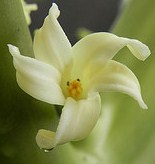Where Does It Fit?

This phylogenetic tree shows how Carica papaya relates to other organisms based on classification. Lets take a closer look at the break down of this fascinating organism.
 |
Eukarya
This domain includes many organisms that most people are familiar with including fungi, protists, plants, and animals. An example of another eukaryotic organism is the chicken (Gallus gallus) General qualities of this domain, including papayas, are all eukaryotic cells have a nucleus, they are much larger than prokaryotic cells and much more complex. |
|
Plante
|
 |
 |
Magnoliophyta
The papaya is a flowering tree which is why it fits into this phylum. Magnoliophytas are more commonly known as angiosperms. Another commonly known angiosperm includes the Hemp plant (Cannabis sativa). |
 Picture provided by MShenan |
Magnoliopsdia This class represents the dicots of the angiosperms. This organism is a dicot because veins in the leaves of a papaya tree have a net like pattern. Also flowers of dicot plants have have parts in 4's or 5's and the papaya flower has 5 petals. An example of another dicot is the Opium poppy plant (Papaver somniferum) |
 |
 |
Brassicales This group is more commonly known as the Cabbage family and includes 15-16 different families with in the order including the species kohlrabi (Brassica oleracea). The main characteristic of organisms in this order is that they produce mustard oils. Radial symmetry in the flowers of these plants is also a characteristic of this organism. |
|
Caricaceae
This family is made up of four different genera all with similar characteristics including soft trunks and production of a milky sap. |
 |
 |
Carica This genus includes all papayas. Most papayas have an enzyme called papain which has been used for many medicinal purposes. |
|
C. papaya This species is a large herb that can reach up to 30 feet in height. The fruit, for what the species is best known for, has a green skin containing an orange melon like fleshy inside. The fruit itself can be quite large reaching up to 20lbs in weight! The name is easy enough to remember as well because its scientific name is the same as its English name. Papaya simply means what it is, a tropical fruit from an evergreen tropical tree. |
 |
Want to know more? Find out where this colorful fruit likes to live by taking a look at its habitat.
Check out more awesome organisms at Multiple Organisms